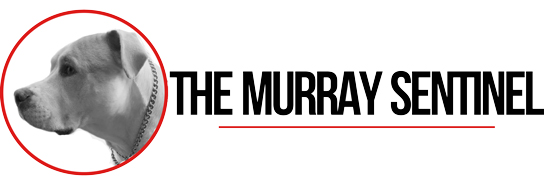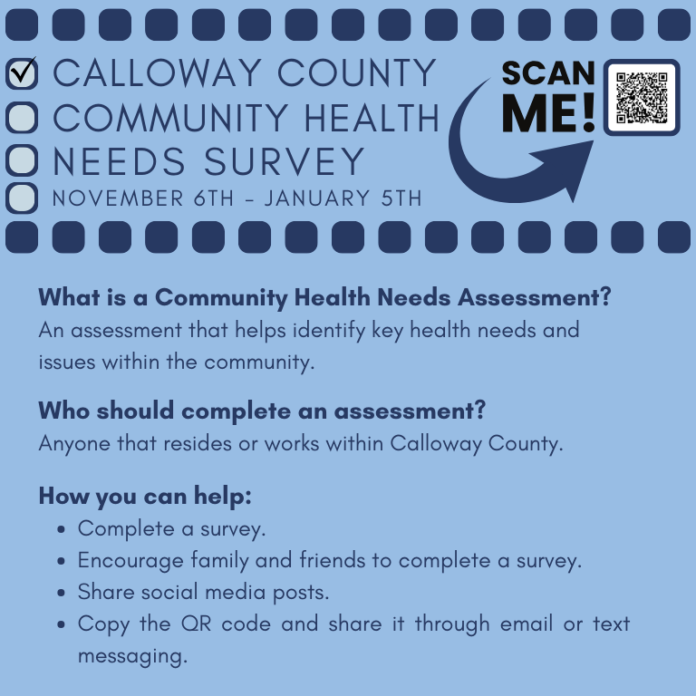MURRAY – For the next eight weeks, residents of Calloway County have a unique opportunity to be a part of building a healthier community. What health issues are important to you? What are the biggest health-related challenges currently facing our community? The Calloway County Health Department wants to know what you think. The request is simple – complete a short survey – but the information gleaned will be used to shape policies and programming to improve the overall health of the greater Calloway County community over the next four years.
CCHD released its 2024 Community Health Needs Assessment last week. People who either live or work in Calloway County have until Jan. 5 to complete the survey, which can be accessed digitally here, by visiting CCHD’s website (callowayhealth.org), or scanning the QR code provided below. Hard copies are available at the health department, 602 Memory Lane, or the survey can be completed over the phone by calling 270-753-3381.
“We’re trying to get it out in the most ways possible so we can get as much information as we possibly can from our community because that’s the best way for us to get data,” said CCHD Public Health Director Jamie Hughes, who advised his goal is to have a 5% response rate.
The crux of public health is to identify and address problems that impact health on a population level, and as such, local health departments conduct community health needs assessments to systematically evaluate a community’s overall health status. Generally, surveys are used to collect information but also serve as a way to solicit input from community members about any public health concerns in the community that are not being adequately addressed.
Developing surveys that capture meaningful data is not as straightforward as it may seem. CCHD staff began working on the 2024 assessment this summer. They evaluated the two most recent assessments, identifying the strengths and weaknesses of each, and looked at assessments from other local health departments to develop a draft.
CCHD contacted more than 80 potential community partners to solicit their involvement in the process of honing the draft to ensure the assessment tracks metrics that will articulate the scope and scale of the community’s public health concerns. Those partners included local government entities, healthcare providers, mental health providers and school districts as well as businesses and nonprofits that offer services to address specific populations, such as the elderly, the unhoused, children/families and those with substance use disorders. Ultimately, representatives from seven local organizations – Murray-Calloway County Hospital, Calloway County School District, Murray Independent School District, Calloway County Emergency Management, Calloway County Extension Service, Murray Woman’s Club and The Murray Sentinel – participated in that process.
Hughes called the development of the 2024 community health needs assessment a “team effort,” noting CCHD staff did their best to incorporate the ideas and insights garnered from meetings with partner organizations into the final assessment.
After identifying the community’s needs and determining what resources are already in place to address them, public health professionals analyze the results and, often in conjunction with partner organizations, determine funding streams and develop programs to fill in the gaps in services. In Kentucky, local health departments conduct needs assessments every four years.
CCHD’s 2016 assessment included 14 questions and a response rate of 4%. Guidance from the Kentucky Department for Public Health suggests rates in the 5-30% range are good response rates. In 2020, there were only nine questions, but the response rate was 1.5%. In addition to having a very low number of responses, the 2020 assessment included several open-response questions, which offer subjective data that can be difficult to quantitatively analyze.
“The last assessment was in the heart of COVID,” Hughes said. “I don’t know because I wasn’t here at the time, but it was almost like they said, ‘We need to get this done. We don’t have the time or the resources or the staff to get this done, so let’s push it out to get it done.’ The survey was shorter, but it provided a lot of places for comments, which I think wound up hindering us more than it helped us.”
The current assessment consists of 32 multiple-choice-style questions, one open-response question – “How would you define a healthy community?” – and a space for comments, with the latter two limited to 300 characters. (This long-winded reporter completed the survey in less than 10 minutes, and most of that time was spent whittling the open responses down to 300 characters.)
One goal for the 2024 assessment was to collect more detailed demographic information. In 2020, respondents were only asked to provide age and household income, whereas the new survey asks about, among other things, gender, race, household size, relationship status and education level as well as public health concerns, like smoking status and having access to running water.
Another addition to the new assessment is a question about the area of the county where respondents live – Almo, Dexter, Hazel, Kirksey, Lynn Grove, Murray, New Concord or Shiloh. Hughes explained that this information will allow CCHD to pull applicable census data for those areas to better understand the assessment results.
“There’s not a ton we can use, but we can use some of the census data and apply it to what we’re seeing in our community,” he said. Hughes noted that the median income in one of Calloway’s census tracts is $34,000, whereas in another tract it is $61,000. He also pointed out there are significant disparities across the county in terms of those with and without health insurance.
“It also can help us,” he explained, noting that it is important to not waste the limited funding available by deploying interventions in areas where they may not be needed. “’What is it we might be able to do differently on one side of the county than we do on the other?’ That’s the idea, and that’s kind of how we look at the assessment in general – each county is different than the state, and our county has its own culture, depending on where you are.”



